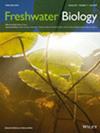Analysis of Macrozoobenthic Species Associations in the Eastern European Plain Under Changing Climatic Zone Conditions
IF 2.8
2区 生物学
Q2 ECOLOGY
引用次数: 0
Abstract
- The assessment of the geographical distribution of species under the influence of environmental factors at different scales is important in ecological studies. This study aimed to investigate macrozoobenthos species associations and determine the factors influencing their co-occurrence, based on data from various climatic zones of the Eastern European Plain.
- We analysed a large dataset from 11 mid-sized and 81 small rivers in the Lower Volga Basin. Using a discrete binomial distribution, we identified pairs of associated species, grouped them and analysed their dependence on various abiotic factors.
- Four clusters of macrozoobenthic species were identified, gradually replacing each other from the forest-steppe to the semi-desert climatic zone. From high to low latitudes, in these clusters the number of rheophilic and freshwater species decreased, while the number of limnophilic, euryhaline and halophilic species increased.
- Species associations with habitat are determined by morphological and physiological adaptations to the complex of abiotic factors within local biotopes, trophic specialisation and facilitative interactions. The abiotic characteristics of the biotopes, in turn, were influenced by the following climatic and landscape factors: Average annual air temperature, precipitation volume influences salinity in the watercourses, and finally, the altitude and ruggedness of the terrain influenced water velocity. These factors constrained the spatial distribution of identified species assemblages to varying degrees.
- The results obtained contribute significantly to our understanding of the geographical distribution of macrozoobenthic assemblages. The methodical approach employed in this study has the potential to facilitate the distribution analysis of other groups of living organisms across diverse spatial scales.
变化气候带条件下东欧平原大型底栖动物群落分析
不同尺度环境因子影响下物种的地理分布评价是生态学研究的重要内容。本研究基于东欧平原不同气候带的数据,探讨了大型底栖动物的物种关联,并确定了影响它们共生的因素。我们分析了伏尔加河下游11条中型河流和81条小型河流的大型数据集。利用离散二项分布,我们确定了成对的伴生物种,对它们进行了分组,并分析了它们对各种非生物因素的依赖性。从森林草原到半荒漠气候带,发现了4个大型底栖动物群落,它们逐渐相互取代。从高纬度到低纬度,这些群落中嗜流和淡水物种的数量减少,而嗜湖盐、广盐和嗜盐物种的数量增加。物种与栖息地的关联是由形态和生理上对当地生物群落中复杂的非生物因素的适应、营养特化和促进性相互作用决定的。反过来,生物群落的非生物特征受以下气候和景观因素的影响:年平均气温,降水量影响水道中的盐度,最后,地形的海拔和崎岖程度影响水流速度。这些因素不同程度地制约了已鉴定物种组合的空间分布。所得结果对我们了解大型底栖动物群落的地理分布具有重要意义。本研究中采用的系统方法有可能促进其他生物群体在不同空间尺度上的分布分析。
本文章由计算机程序翻译,如有差异,请以英文原文为准。
求助全文
约1分钟内获得全文
求助全文
来源期刊

Freshwater Biology
生物-海洋与淡水生物学
CiteScore
5.90
自引率
3.70%
发文量
162
审稿时长
2 months
期刊介绍:
Freshwater Biology publishes papers on all aspects of the ecology of inland waters, including rivers and lakes, ground waters, flood plains and other freshwater wetlands. We include studies of micro-organisms, algae, macrophytes, invertebrates, fish and other vertebrates, as well as those concerning whole systems and related physical and chemical aspects of the environment, provided that they have clear biological relevance.
Studies may focus at any level in the ecological hierarchy from physiological ecology and animal behaviour, through population dynamics and evolutionary genetics, to community interactions, biogeography and ecosystem functioning. They may also be at any scale: from microhabitat to landscape, and continental to global. Preference is given to research, whether meta-analytical, experimental, theoretical or descriptive, highlighting causal (ecological) mechanisms from which clearly stated hypotheses are derived. Manuscripts with an experimental or conceptual flavour are particularly welcome, as are those or which integrate laboratory and field work, and studies from less well researched areas of the world. Priority is given to submissions that are likely to interest a wide range of readers.
We encourage submission of papers well grounded in ecological theory that deal with issues related to the conservation and management of inland waters. Papers interpreting fundamental research in a way that makes clear its applied, strategic or socio-economic relevance are also welcome.
Review articles (FRESHWATER BIOLOGY REVIEWS) and discussion papers (OPINION) are also invited: these enable authors to publish high-quality material outside the constraints of standard research papers.
 求助内容:
求助内容: 应助结果提醒方式:
应助结果提醒方式:


